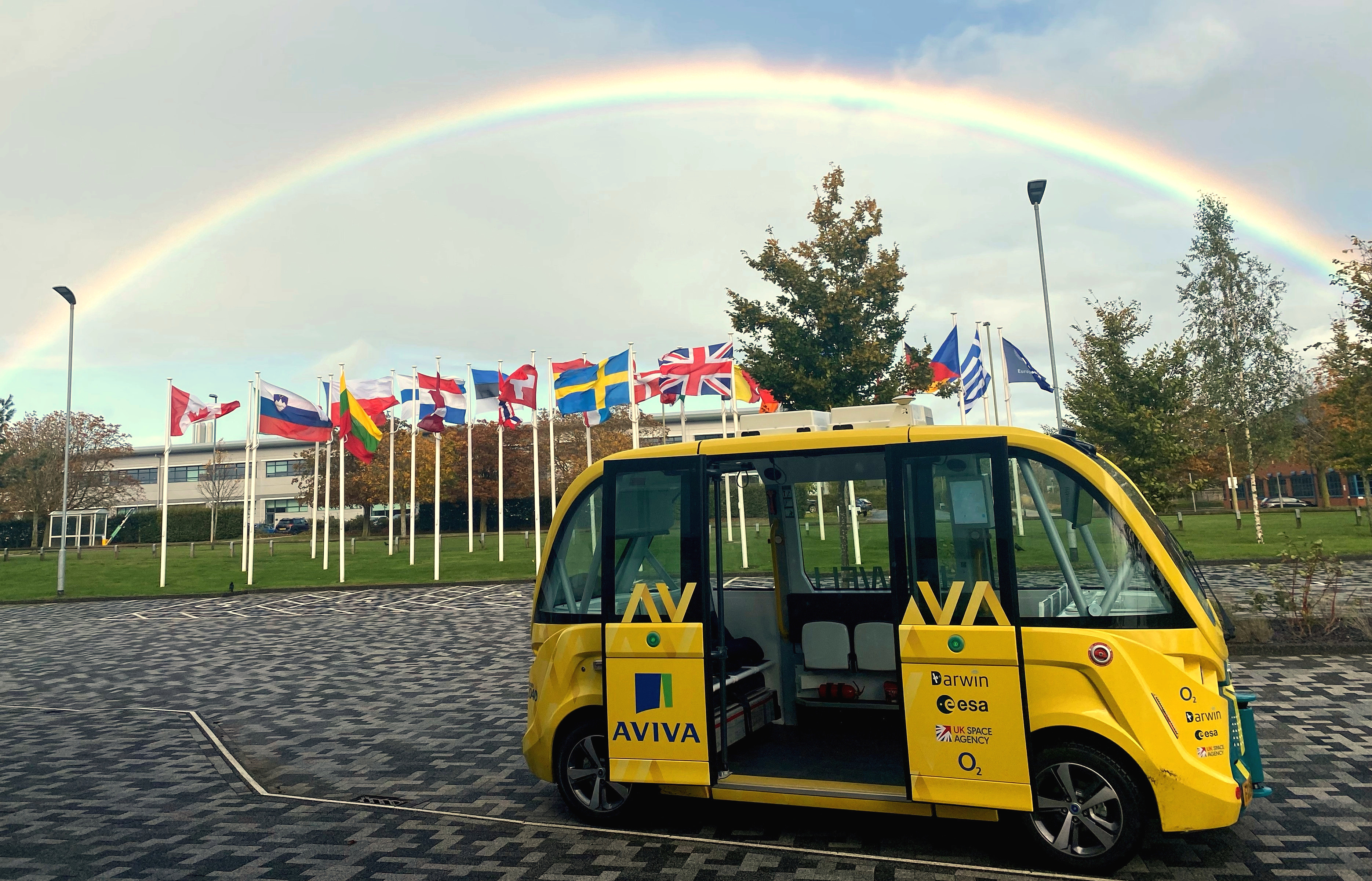European Space Agency-funded continuously connected autonomous shuttle completes two-year trial

A two-year trial for a UK-based autonomous vehicle, which makes use of communications technology developed by the Darwin Innovation Group and co-funded by the European Space Agency (ESA) and the UK Space Agency, has been successful. The milestone makes it one of the longest running trials of such vehicles and offers a step forward in improving road safety and reducing greenhouse gas emissions.
The Darwin Autonomous Shuttle, a self-driving bus that since November 2021 has ferried more than 1,400 passengers over 12,300 kilometres around the Harwell Science and Innovation Campus – home to ESA’s European Centre for Space Applications and Telecommunications (ECSAT) – makes use of a combination of 4G, 5G and satellite technology. This enables the shuttle’s continuous connectivity, allowing its position to be tracked precisely and for live telematics data to be collected for UK regulatory and insurance purposes. For now, the vehicle must have a safety operator on board due to UK regulations.
With a maximum speed of 18 kilometres per hour, the shuttle alternates between a pair of two-kilometre routes around the campus beginning at ECSAT and both of which include a selection of roundabouts, zebra crossings, junctions, public roads and traffic.
Harwell Campus doesn’t have public 5G coverage, so the vehicle is operated through a private 5G network supplied by Virgin Media O2, which permits the shuttle’s software to switch between private and public networks, an essential feature for the future of connectivity across industrial areas, ports and airports. Meanwhile, the shuttle’s satellite connectivity is provided by Hispasat, should the 5G and 4G coverage become unavailable.
The beauty of the shuttle’s technology is that it can switch seamlessly between 5G, satellites and 4G based on availability, ensuring that so-called connected autonomous vehicles (CAVs) are always connected. This is one of many features that ESA’s Directorate of Connectivity and Secure Communications’ Space for 5G/6G programme line is supportive of on the project, with the team helping to investigate how communications networks in space can be integrated with terrestrial networks.
“ESA is excited to champion the Harwell shuttle service, a project that will showcase the reliable, instant 5G connectivity delivered by converged space and ground telecommunications networks, and bring low-emission, autonomous vehicles to the roads,” said Antonio Franchi, Head of ESA’s 5G/6G Non-Terrestrial Networks (NTN) Programme Office.
"An initiative of the project is to be the longest running CAV service in the UK, and to test switching capabilities between a 5G public network, satellite and 5G private networks," said Roberta Mugellesi Dow, ESA's Darwin Technical Officer and Business Applications Manager. "ESA is looking forward to continuing the project with the aim of providing a CAV on-demand service, remote control of CAVs, a cybersecurity framework for CAV operation and CAV implementation in other environments such as ports and high-security areas."
With the success of the trial, co-funded by the UK government, industry and academia, ESA will continue in their support of the initiative, to explore ways to enhance and expand the shuttle service, which includes making use of a second self-driving shuttle that will allow for testing tandem work and longer service hours, as well as further testing of remote operation, cybersecurity and operation in ports and airports.
The ultimate plan is to supply its connectivity technology to vehicle manufacturers, giving them the ability to switch seamlessly between terrestrial and satellite networks, therefore never losing connection – even when travelling in areas with poor cellular coverage. The shuttle’s technology could also offer opportunities for public transport in areas that are economically impractical, receive real-time requests from passengers heading to a destination and alter its route to pick people up, as well as allow customers to track the location of available vehicles, even if the mobile coverage is patchy.
“We have tested remote control of the shuttle (without a safety driver present onboard) and a 12-hour service with two shuttles taking shifts, with a view to permanently establishing a second shuttle and longer service hours,” said Daniela Petrovic, a co-founder of Darwin.
ESA’s Space for 5G/6G programme sets the standards and frameworks for hybrid and downstream interoperability, as well as the base for integrating terrestrial networks with satellites. For funding opportunities, visit the esa-star Publication System.
ESA supports the development of ubiquitous, reliable and secure connectivity solutions for the automotive of the future, and is speeding up its efforts to use space to combat the climate crisis through three Accelerators, one of which includes Space for a Green Future.


